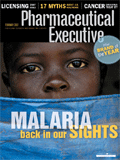Alternative Media: Stop, Click, and Listen
By using rich-media components and data-collection tools in online advertising campaigns, marketers can gather valuable customer information and stimulate brand awareness among their target audiences.
Hear that? That's the sound of consumers not clicking on your online ad. They've smartened up and realized that a static banner ad is just going to lead them away from the site they are pursuing, costing them valuable time and effort. For a less-invasive ad experience, brand managers have turned to rich-media-enhanced advertising, which offers all the information consumers need—without ever having to leave the page.

Chris Saridakis
Getting Rich
So, what exactly is rich-media advertising? A general definition refers to online ad units that contain sound, video, animation, interactivity, product demos, and games—all within the confines of a standard-size online ad. However, rich media is much more than cool features—with rich features come richer metrics.
Rich-media advertising offers brand managers all the tracking functionality of a traditional Web site. Additionally, companies can track the amount of time a consumer spends interacting with an ad, the time the ad was displayed on the page, and various levels of user engagement.
Within rich-media ads, online users can interact with pharmaceutical brands by watching animated drug details, downloading coupons or free trial offers, participating in patient surveys/polls, and even setting medication reminders in their personal e-mail or calendar programs.

Organon's campaign for NuvaRing features a rich-media-enhanced ad that allows users to print a voucher for a free sample without being redirected to another site.
Driving Direct Response
HeartBeat Digital created a rich-media campaign for Organon's NuvaRing product, featuring interactive ad technology that pushes detailed content directly to consumers. Within the ad, users can print a voucher for a free sample of the NuvaRing product without being redirected to another site or being required to provide further user information. The NuvaRing rich-media ads are treated as an extension of the company's branded site, rather than a means to drive consumers to the site. The creative material was placed on Web sites and portals where the target audience finds the majority of their health information, effectively delivering both product messages and coupon offers.
Additionally, by monitoring brand-interaction time, NuvaRing is able to track users' time spent and actions taken on the site, and optimize the campaign accordingly. Brand marketers also track how many coupons remain in the database at the end of each day, thereby accounting for how many coupons are downloaded on a daily basis. This measurement capability allows for an accurate projection of daily results.

Beyond Advertising Richer Clinical Trials
Pharma Calling
Failing to remember when to take medications is a common cause for drop off in treatment adherence. To combat this, pharmaceutical brand managers can execute a rich-media online-advertising campaign featuring an interactive calendar reminder. These types of campaigns are particularly effective when attempting to stimulate adherence for non-daily medications or for seasonal prescription treatments.
For example, the calendar-reminder functionality can be used as part of a seasonal-allergy-medication campaign to remind patients to refill their prescriptions and reinforce the importance of taking medication regularly. The rich-media ad allows users to enter their treatment schedule directly into the advertisement, which automatically syncs the data with the user's personal e-mail or calendar program.
Pharmaceutical brand managers also can embed interactive symptom selectors within an online advertising unit to engage consumers and better educate them on potential conditions and treatments. Symptom selectors allow individuals who think they may be potential candidates for a specific treatment or medication to select from a list—again, within the ad unit—of symptoms they are experiencing.
After data entry is complete, the ad unit provides an assessment based on selected symptoms, and detailed information on potential treatment options. The ad also captures opt-in information, and e-mails the user a copy of his or her assessment to print out and share with a doctor.
Data Mining
Although rich-media ads are typically used to enrich the customer experience and provide an increased level of health-related information, they also provide pharmaceutical brand managers with an innovative tool for increasing brand interaction and acquiring customer data. By including interactive components and data-collection tools in an online advertising campaign, marketers can gather valuable customer information and stimulate brand awareness among their target audiences.
For example, a rich-media ad unit for a new pharmaceutical brand could feature several video segments of potential candidates for a new television commercial. Online users could view each of the proposed commercials—directly from within the ad unit, without having to leave their current online destination—and vote on the commercial they like best.
At the end of this campaign, pharmaceutical brand managers have not only gained a clearer indication of which commercials resonate with their target audiences, but also created an increased level of brand awareness and interaction among the desired patients.
Data-collection tools, such as registration data, contact details, and information requests, provide pharma brand managers with another means to generate leads. Data-collection fields are defined as standard HTML forms, so they are as easy to design as the data-collection fields on any standard Web site. Online users fill out the form elements within a panel on the online ad and submit the information to a server-hosted submission script to process the data.
As a result, pharmaceutical brand teams receive valuable customer data and actionable leads, while consumers receive greater information in the form of hard copy brochures/education kits, or discounts on products.
Just What the Doctor Ordered
As pharmaceutical brands shift to an online state of mind, they need to engage users in ways that foster longer brand-interaction times and deliver content-rich experiences. Rich-media advertising addresses these needs and allows brands to extend the reach of their campaigns both online and off.
Ultimately, the end goal in all pharmaceutical-related advertising is to educate the consumer and positively improve compliance and adherence. Rich-media ads allow for a non-intrusive, fully interactive brand experience that ultimately leads to a more informed doctor–patient dialogue and empowers consumers to take a more active and educated role in their healthcare.
Chris Saridakis is CEO of PointRoll. He can be reached at csaridakis@pointroll.com
